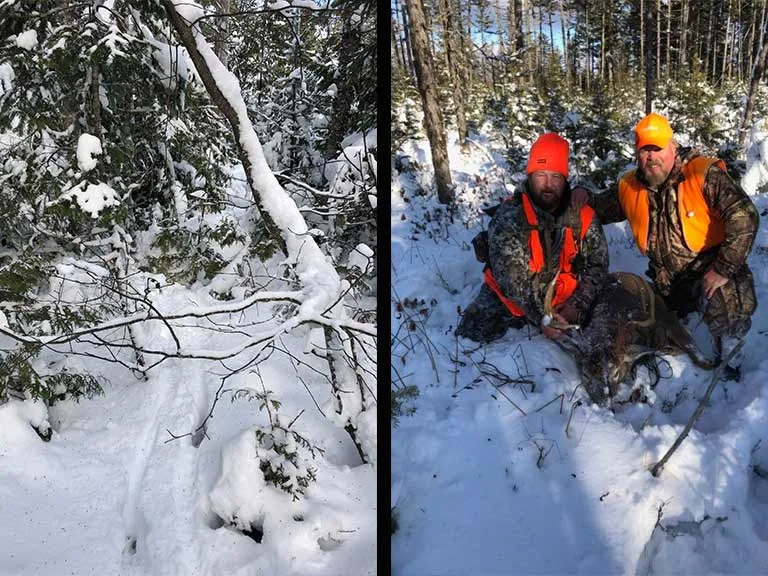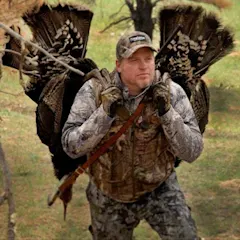Last year around this time, my buddy Randy Flannery of Wilderness Escape Outfitters
in Danforth, Maine, texted me a photo (below, left) of deep-set buck tracks cutting through a snow-covered cedar swamp. “Guiding a guy from PA,” the text read. “He’s getting a lesson in tracking.” That was at 11:50 a.m.
At 2:45, he sent me another snapshot (below, right), of himself and his client with a nice North Woods 8-pointer.
What this shows, of course, is that now (assuming your season is still open) is the time to get on a track and catch up to the buck that made it. While most deer hunters wait all year for the rut, trackers wait for the rut to be over. Bucks cover so much ground searching for does during the breeding season, that it is very difficult to catch up to them, even on a super-fresh track. But right now, with bucks recuperating from the rut and preparing for the worst of winter, it’s prime time for tracking.

Left: Deep-set buck tracks. Right: Guide Randy Flannery and his client, with the buck they’d been tracking. Randy Flannery
“Recovery-phase bucks are on a simple bed-to-feed pattern and covering far less ground than they were a month ago,” says Flannery. “If you put me on a fresh track this time of year, I can just about guarantee that I’ll catch up to that buck.”
As a guide, Flannery rarely goes one-on-one with a winter buck because he’s usually helping someone else fill a tag. But even when he doesn’t have a client, he enjoys working with a partner. “When my son Scott is home during the late season, there’s nothing I like better than teaming up with him to track down an old buck.”
How to Track Deer as a Team
After a fresh snowfall, the Flannerys get up before dawn, drive logging roads, and scan for the dark prints of deer tracks crossing under the beam of the headlights. “We’re looking for a print that’s about as wide as a .30-06 cartridge is long and less than three hours old. Once we find it, we make up our minds to either kill that buck or run out of daylight.”
Randy follows the track, straddling it while Scott flanks him 50 to 60 yards away on the high side. “When a buck beds down or circles to check his backtrack, he’ll usually J-hook on the uphill side, giving the flanker the best chance.” Still, Flannery says, the tracker shouldn’t stare at the ground. “Follow the prints with your eyes as far as you can, then walk to that point while looking for the buck out front and to the sides.”
When the trail indicates that the buck has starting going up and down grades or zigzagging between thick evergreens and blowdowns, he is getting ready to bed. “This is when you need to slow way down,” Flannery says. “Expect a J-hook coming up, and if you can, hand signal to your flanker to stay on his toes.” As long as the flanker is still on the high side (switch sides while tracking if the terrain changes), he’ll have a slightly better chance of spotting the buck—and this is no time to be in a hurry. Both hunters should now take one slow step at a time, and then meticulously scan the cover ahead for any part of a deer. “With a little luck, the flanker will catch that buck still lying down or just getting up from his bed,” says Flannery. “But the tracker has a good chance too, and it’s not unusual for one hunter to bump the buck toward the other. So no matter what, both need to be ready to shoot fast.”
Finally, the Maine guide points out one more big advantage to tracking with a partner: “When it all comes together and you do track a buck to its bed and make a good shot—that’s when it usually occurs to you how far back into the wilderness you are. It makes a huge difference to have a partner to help you drag or pack out your trophy.”






